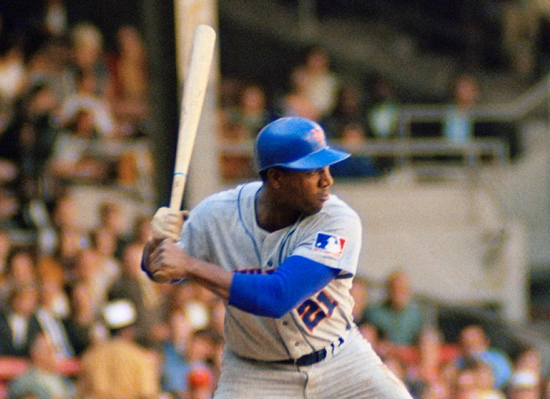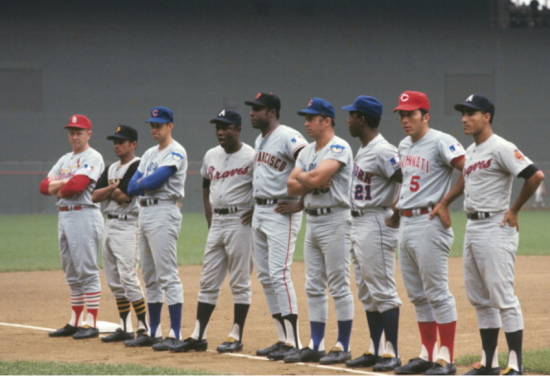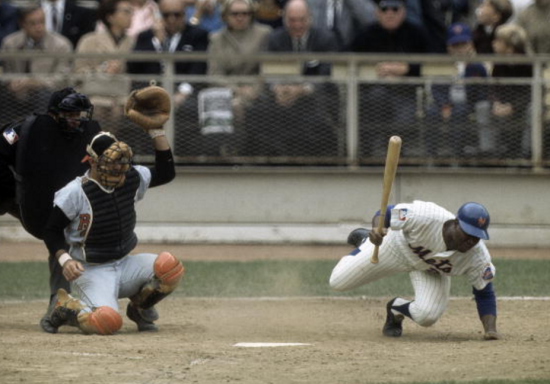
Today, when America stops to remember its greatest civil rights leader, we thought it is appropriate to remember Cleon Jones, the team’s first African American All-Star.
Cleon Jones signed with the New York Mets at the age of 20 in 1963, before baseball had initiated the annual amateur draft. After batting over .300 for both the Carolina League Raleigh Mets and New York–Penn League Auburn Mets, Jones received a September call-up to the major league club, thereby skipping both AA and AAA. Jones had two hits in 15 at-bats for a .133 batting average during his 1963 stint with the New York Mets.
Jones was the team’s starting center fielder in 1966, and had a fine season, batting 275 with eight home runs, 57 RBIs, and 16 stolen bases. Jones was fourth in the Rookie of the Year voting that season. In 1967, Cleon Jones’ batting average dipped to .246, and he ended up sharing playing time with Larry Stahl. Following the season, the Mets acquired Jones’ childhood friend Tommie Agee from the Chicago White Sox. With the former gold glover Agee in New York, Jones was moved to left field.
In 1968, Jones had an outstanding season, batting .297 which was a fantastic batting average (sixth in the league) in the Year of the Pitcher. Jones had 29 doubles, 14 homers and 55 RBIs. His OPS of .793, was 37% better than average.

Building on his wonderful 1968 campaign, Cleon Jones batted an incredible .341 with ten home runs and 56 RBIs in the first half of 1969 earning the starting left field job for the All Star game, ahead of contemporaries such as Billy Williams, Willie Stargell, and Jesus Alou. In the game, Cleon represented the Mets quite well, going 2-for-4 with two runs scored in the NL’s 9–3 victory.
Cleon Jones was the team’s hitting star of the rising Mets, with a team-leading batting average well above .330. The Amazins found themselves in second place, five games back of the Chicago Cubs in the new National League East (1969 was the first year of divisional play) when the Houston Astros came to Shea Stadium for a July 30 double-header.
After losing the first game 16–3, the Mets were down 7–0 in the third inning of the second game when Johnny Edwards hit a double off of Nolan Ryan to Jones in left field to make the score 8–0. Mets manager Gil Hodges emerged from the dugout, walked past Nolan Ryan on the mound, and walked all the way out to left field. A few minutes later, Hodges walked back to the dugout, with Jones a few paces behind him, and replaced Jones in left with Ron Swoboda.

Newspapers at the time said Jones suffered a leg injury and he was not in the Mets lineup for several games after July 30. Later accounts say that Jones was removed for failure to hustle, and Hodges decided to do so publicly to show that he would not tolerate lack of effort on his team, even from its star player.
In a 2009 interview, following pre-game ceremonies honoring the 40th anniversary of the “Miracle Mets”, Jones discussed the incident during a telecast of that night’s game. Jones said Hodges asked him why he did not look good going after a fly ball on the previous play. According to Jones, he pointed down to the water-filled turf. Hodges then said that something must be wrong with Jones’s ankle and pulled him for that reason. Cleon Jones stated he believes that the fear instilled in other players by the incident was the turning point in the season.
As a reminder, in 1969 the Mets rallied to overtake the Cubs, Sweep Hank Aaron and the Braves in the playoffs (Jones batted .459 against Atlanta) and became World Champions by beating the heavily favored Orioles in the World Series with Cleon Jones making the final catch.
Cleon Jones, the Mets’ first African All Star, was inducted into the Mets Hall of Fame in 1991 and is also one of the eight inductees in the Metsmerized Hall of Fame. Well deserved honors for one of the franchise’s first young hitting star.














